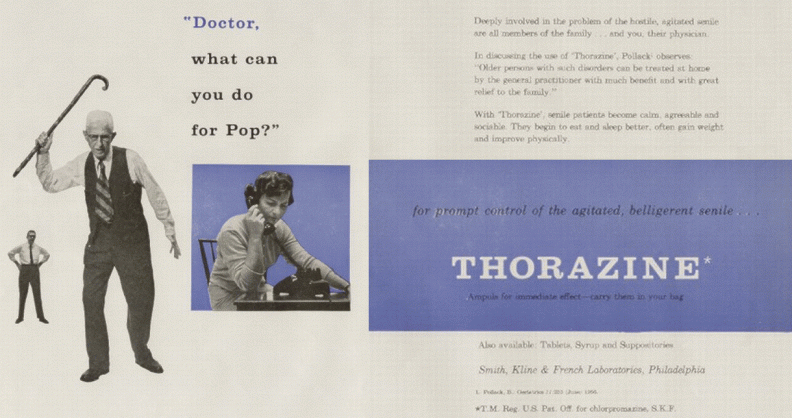By Abraham Flinders, MD
Case:
HPI: 25 yo female recently hospitalized for acute manic episode where she was started on haloperidol 10mg QHS now presents with trouble walking, trouble talking, drooling and rigidity.
PE: Her vitals are normal except for a heart rate that jumps to 120 intermittently. She is alert and oriented x 4. She has full range of motion in her neck, except it is rigid. Her oropharynx is clear. Her neuro exam shows CN2-12 intact bilaterally. Her motor and sensory is intact except she is bradykinetic and rigid in both upper and lower extremities. Her gait is shuffling and ataxic, unable to assess Romberg.
Differential:
- HENT disaster
- Neuromuscular disorder
- Medication side effect
Course: Patient given IV diazepam and benztropine with subjective improvement. She is admitted to the ICU and all antipsychotic medication is discontinued. She is discharged from hospital on day 4 with complete resolution of her symptoms, started on clonazepam.

Thorazine advertisement from 1966
Discussion:
Antipsychotics act primarily as dopamine antagonists. There are five well documented disorders that are more commonly seen with typical (1st generation) antipsychotics such as thioridazine, chlorpromazine, haloperidol, droperidol.
1- Acute Dystonia: develops hours to days and is characterized as sustained, involuntary muscle contraction. This ranges from torticollis to oculogyric crisis and one must beware of the laryngeal spasm which may require paralysis and intubation. Treatment is anticholinergics, usually 2mg IM/IV benztropine.
2- Akathisia: develops hours to days, characterized by restlessness/unease (can’t sit still). Treatment is to decrease the dose or add in beta blocker.
3- Parkinsonism: usually takes weeks to develop and is noticed by outpatient psychiatrist rather than an ED presentation. Bradykinesia, rigidity, shuffling gait, mask-like, facies, resting tremor. Treatment is to decrease dose, IV benztropine (best described) or dopamine agonists. Most commonly seen in elderly women.
4- Neuroleptic Malignant Syndrome: life threatening illness that develops in 2-10 days, can happen with just one dose of antipsychotic and can kill with profound hyperthermia. The quadrad is AMS, hyperthermia, upper and lower lead pipe rigidity and autonomic instability (Delphi Criteria). Often have elevated CK and can get rhabdomyolisis. These patients need admission to ICU, large doses of IV benzodiazepenes, cooling measures and sometimes intubation and paralysis. Can consider IV dantrolene* although this is theoretical and not proven with EBM. Can consider pro-dopamine agents (bromocriptine)**.
5- Tardive Dyskinesia: develops in 3 months to years which is characterized by involuntary choreiform and buccolinguomasticatory movements. Trick is to recognize early and discontinue the medication.
*dantrolene is 50-100mg/day PO up to 10mg/kg/day IV.
** bromocriptine is 2.5-10mg 3-4x/day PO.